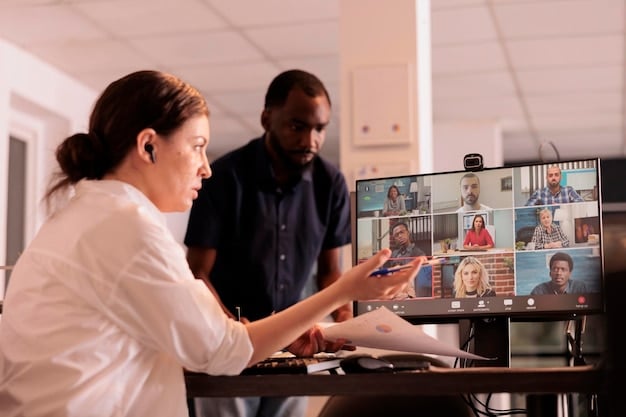Practical Guide: How to Create Engaging Online Community Events Attendees Want

A practical guide on how to create engaging online community events that people actually want to attend involves strategic planning, understanding member needs, leveraging interactive tools, and consistent promotion, aiming to foster deeper connections and sustained participation within the digital space.
In the digital age, online communities have become vital hubs for connection, learning, and collaboration. However, merely existing isn’t enough; true engagement blossoms when members feel a sense of belonging and value. This practical guide: how to create engaging online community events that people actually want to attend delves into the strategies and tactics required to transform virtual gatherings from simple meetings into dynamic, must-attend experiences.
Understanding Your Community: The Foundation of Engagement
Before launching any event, a deep understanding of your community’s demographics, interests, and pain points is paramount. This foundational knowledge allows you to tailor events that genuinely resonate with your members, moving beyond generic offerings to truly impactful experiences. Without this insight, even the most well-intentioned event can fall flat, failing to attract the desired participation or deliver meaningful value. It’s about listening more than speaking.
Effective community managers often employ various methods to gather this crucial intelligence. Surveys, polls, direct feedback through forums or social media, and even observing conversation trends can provide a wealth of information. The goal is to identify common threads, shared aspirations, and recurring challenges that an event could address, solve, or celebrate.
Conducting Needs Assessments
A systematic approach to understanding your community’s desires starts with a comprehensive needs assessment. This isn’t just about asking what events they want, but probing deeper into their motivations and what they hope to gain from such interactions. What skills do they want to learn? What discussions are they eager to have? What problems are they trying to solve?
- 📊 Surveys and Polls: Utilize tools like SurveyMonkey or Google Forms to gather quantitative and qualitative data on topics of interest, preferred formats, and ideal timings.
- 💬 Direct Feedback Channels: Encourage open dialogue in dedicated community channels, asking members what types of events would be most beneficial to them.
- 👁️ Behavioral Analysis: Observe which posts get the most engagement, what questions are frequently asked, and which topics spark the most lively discussions. This reveals underlying interests.
Once you’ve collected this data, analyze it for patterns and common themes. This iterative process of listening and learning ensures your event strategy remains agile and responsive to the evolving needs of your community. It’s a continuous conversation, not a one-off interrogation.
Strategic Event Planning: Crafting Irresistible Experiences
With a clear understanding of your community’s needs, the next step is to translate those insights into a compelling event concept. This stage involves defining clear objectives, selecting the right format, and conceptualizing content that promises high value. The success of an event often hinges on meticulous planning that prioritizes member experience at every turn. It’s about building excitement from the ground up.
Avoid the temptation to simply replicate what others are doing. Instead, focus on what makes your community unique and how an event can amplify that distinctiveness. Innovation doesn’t always mean complexity; sometimes, simplicity and authenticity are the most powerful drivers of engagement.
Defining Clear Objectives and Formats
Every event should have a defined purpose. Is it to educate, entertain, foster networking, or celebrate achievements? Clear objectives provide a roadmap for content creation and measurement of success. The format chosen should naturally align with these objectives, enhancing the participant’s experience.
- 💡 Education & Learning: Webinars, workshops, panel discussions, Ask Me Anything (AMA) sessions with experts.
- 🤝 Networking & Connection: Breakout rooms, virtual speed networking, interest-based chat groups, casual “coffee break” sessions.
- 🎉 Entertainment & Celebration: Virtual game nights, talent shows, community awards, themed parties.
- 🗣️ Discussion & Collaboration: Moderated forums, collaborative brainstorming sessions, “open mic” Q&A forums.
Consider the desired outcome for attendees. Do you want them to leave with new knowledge, new connections, or simply a feeling of belonging? This clarity guides every subsequent planning decision, from choosing speakers to designing interactive elements.

Leveraging Technology: The Right Tools for Engagement
The choice of platform and interactive tools can make or break an online community event. Technology should serve as an enabler, not a barrier, facilitating seamless interaction and enhancing the overall experience. Being familiar with a range of options allows you to select solutions that best fit your event’s goals and your community’s technical comfort level.
Experimentation with different tools is often necessary to discover what truly resonates with your audience. What works for one community might not work for another. The key is to prioritize user-friendliness and features that support your engagement strategy.
Selecting the Optimal Platform
The event platform is the virtual venue. Its capabilities directly impact the potential for interaction and the feeling of presence. Consider factors like participant capacity, interactive features, ease of access, and cost efficiency. Reliability and stability are also non-negotiable for a smooth event.
- 🎥 Video Conferencing Solutions: Zoom, Google Meet, Microsoft Teams offer robust features for presentations, screen sharing, and breakout rooms.
- 🌐 Dedicated Event Platforms: Platforms like Hopin, Remo, or Run The World are designed specifically for virtual events, often with advanced networking functionality.
- ⚡ Community-Specific Tools: Some community platforms (e.g., Discord, Slack with integrations) can host smaller, more informal events within their ecosystem.
Beyond the primary platform, consider supplementary tools for polls (e.g., Slido), real-time Q&A, collaborative whiteboards (e.g., Miro), and virtual icebreakers. Integrating these seamlessly adds layers of interactivity and keeps participants actively involved.
Promotion and Registration: Building Anticipation
Even the most perfectly planned event will fall flat without effective promotion. Building anticipation and making the registration process as smooth as possible are crucial steps in ensuring a strong turnout. Your promotional strategy should be multi-faceted, reaching your community where they are most active.
Think of promotion not just as an announcement, but as storytelling. What problem does this event solve? What unique opportunity does it offer? How will attendees feel after participating? Answering these questions helps craft compelling messaging.
Crafting Compelling Marketing Messages
Your promotional materials should clearly communicate the event’s value proposition, key takeaways, and who will benefit most from attending. Use engaging language and strong calls to action. A strong hook is essential to capture attention in a crowded digital landscape.
Consider different channels for promotion:
- 📧 Email Newsletters: Your most engaged members are often on your email list. Segment lists if possible to target specific interests.
- 📱 Social Media: Tailor content for each platform (e.g., Instagram stories, LinkedIn posts, Twitter threads). Use relevant hashtags.
- 📣 Community Forums/Groups: Announce directly within your online community spaces, encouraging members to share.
- partnerships with relevant influencers or organizations to extend your reach.
Early bird incentives, limited spots, or exclusive content for attendees can also boost urgency and motivate early registration. A well-designed landing page for registration that clearly outlines the agenda and speaker bios further enhances credibility.
Execution and Facilitation: Bringing the Event to Life
The day of the event is when all your planning comes to fruition. Smooth execution and skillful facilitation are what transform a collection of attendees into an engaged community. This requires careful attention to technical details, effective moderation, and a commitment to fostering an inclusive and welcoming environment.
Anticipate potential challenges and have contingency plans. Technology glitches, unexpected participant behavior, or time management issues can arise. A prepared team can navigate these gracefully, minimizing disruption and maintaining a positive atmosphere.
Engaging Audiences During the Event
Passive attendance is the enemy of engagement. Actively encourage participation through various interactive techniques. Remember that online environments often require more overt prompts for interaction than in-person gatherings.
- 🎙️ Interactive Q&A: Use live polls, open chat for questions, or dedicated Q&A tools to give everyone a voice.
- 🧩 Breakout Rooms: For networking or small group discussions, these are invaluable for building deeper connections.
- 🎲 Gamification: Quizzes, trivia, or scavenger hunts can add an element of fun and friendly competition.
- 🔄 Real-time Feedback: Encourage use of reaction emojis or quick polls to gauge understanding and interest throughout the event.
The facilitator plays a crucial role in setting the tone, guiding discussions, and ensuring that all voices are heard. Active listening, empathetic responses, and the ability to adapt to the room’s energy are vital skills. Encourage video participation to foster a stronger sense of presence, but respect those who prefer to remain off-camera.
Post-Event Engagement: Sustaining the Momentum
The event doesn’t end when the live session concludes. Post-event activities are critical for sustaining momentum, reinforcing key messages, and deepening community ties. This is your opportunity to extend the value, gather feedback, and lay the groundwork for future successful gatherings.
Many community managers overlook this crucial phase, missing out on opportunities to convert event attendees into long-term active participants. Thoughtful follow-up demonstrates your commitment to your community and reinforces the value they derived.
Maximizing the Event’s Impact
A structured approach to post-event engagement ensures that the energy generated during the event doesn’t dissipate quickly. This involves a mix of practical follow-up and strategic content delivery.
Key post-event actions include:
- 📧 Thank You & Resource Sharing: Send personalized thank-you emails with links to recordings, slides, and any other promised resources.
- 👂 Feedback Collection: Distribute post-event surveys to gather constructive criticism and insights for continuous improvement.
- 💬 Continued Discussion: Create dedicated forum threads or chat channels for ongoing discussions related to the event’s topics.
- ✍️ Content Creation: Repurpose event content into blog posts, short video clips, infographics, or social media snippets.
- 🎯 Future Event Teasers: Hint at upcoming events or series to keep the community looking forward to the next interaction.
Analyzing feedback is paramount. What worked well? What could be improved? This data-driven approach allows for continuous refinement of your event strategy, ensuring each subsequent event is even more engaging and impactful than the last. Success is built on learning from every experience.

| Key Principles | Brief Description |
|---|---|
| 💡 Audience Insight | Understand community needs through surveys and feedback. |
| ✍️ Clear Planning | Set precise event objectives and choose suitable formats. |
| 🛠️ Tech Utilization | Select reliable platforms and integrate interactive tools. |
| 🚀 Sustained Engagement | Promote effectively and conduct thorough post-event follow-up. |
Frequently Asked Questions
▼
Choosing the right platform depends on your event format, audience size, and desired interactive features. Consider factors like ease of use, cost, and specific functionalities such as breakout rooms, live polling, or dedicated networking areas. Zoom, Google Meet, and specialized event platforms like Hopin are popular choices, each with unique strengths.
▼
Effective promotion involves a multi-channel approach. Utilize email newsletters, active community forums, and various social media platforms with tailored content. Create compelling messages highlighting the event’s value and clear calls to action. Consider early bird incentives or exclusive content to drive early registrations.
▼
To maximize engagement, incorporate interactive elements like live Q&A sessions, polls, breakout rooms for smaller discussions, and gamification (quizzes or trivia). Encourage participants to turn on their cameras and actively contribute. A skilled facilitator is crucial for guiding discussions and maintaining a dynamic environment.
▼
Post-event engagement is vital. Send thank-you emails with recordings and resources, and distribute surveys to gather feedback. Continue discussions in community forums, repurpose event content for broader reach, and tease future events. This sustains momentum and strengthens community bonds, ensuring long-term participation.
▼
Measuring success goes beyond just attendance. Track engagement metrics like chat participation, poll responses, and time spent in breakout rooms. Collect feedback through post-event surveys on content quality and overall satisfaction. Analyze if the event met its objectives, such as increased knowledge or new connections made by participants.
Conclusion
Creating engaging online community events is an art form that blends meticulous planning, technological acumen, and a deep understanding of human connection. From the initial needs assessment to the final post-event follow-up, every step is an opportunity to strengthen bonds, deliver value, and ensure your community thrives. By prioritizing genuine interaction and consistently seeking feedback, you can curate virtual experiences that not only attract attendees but leave them looking forward to the next collaborative journey, turning passive members into active, passionate participants.





